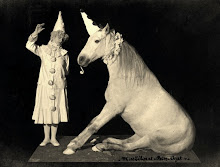As someone partial to both the brain and The Brain, I think this is pretty fantastic:
Tuesday, April 13, 2010
Monday, April 5, 2010
So it turns out nicotine isn't all bad...
I’m taking this great class on drugs right now (well, this is the last week of classes, so not for much longer), and I was reading some articles on nicotine as a treatment for Parkinson's (!?!?!), and I learned something really neat. Apparently, nicotine can be used to reduce dyskinesias associated with the drug Levodopa (L-dopa), which is basically the gold standard in Parkinson’s treatment. Dyskinesias are abnormal involuntary movements (Quik et al., 2007), and are an uncomfortable side effect of the treatment. Since pretty much everyone with Parkinson’s takes L-dopa (and these side effects are fairly common), this is incredible news.
Quik, O’Leary & Tanner (2008) do a great job of outlining the nicotinic and dopaminergic interactions in the nigrostriatal region (see below for references to the articles). Their study explains that presynaptic nicotinic receptors regulate dopamine release, and dopamine receptor antagonists can block nicotine-evoked changes in locomotor activity (Quik et al., 2008), two key aspects in understanding the basis behind treating the side effects of L-dopa with nicotine.
Quik, Cox, Parameswaran, O’Leary, Langston & DiMonte (2007) hypothesize that the cholinergic system may play a role in modulating L-dopa-induced dyskinesias. Their study, using non-human primates, gives results that support this idea, too... they also postulate in their discussion that nicotine may even directly influence postsynaptic nicotine receptors, which in turn modulate other neurotransmitter systems which are implicated in dyskinesias (2007). This theory on postsynaptic involvement is supported by the preservation of nigrostriatal function associated with chronic nicotine administration (Quik et al., 2007).
Now, to be clear, nicotine does not regenerate areas of the nigrostriatal region that are damaged in Parkinson’s (Huang et al., 2009). Studies do show, however, that it is quite effective as a both a neuroprotective agent when given prior to nigrostriatal damage, as well as being useful in non-human primates and rats in attenuating the side effects of L-dopa. Pretty amazing stuff.
References
Huan L. Z., Parameswaran, N., Bordia, T., McIntosh, J. M., Quik, M. (2009). Nicotine is neuroprotective when administered before but not after nigrostriatal damage in rats and monkeys. Journal of Neurochemistry, 109: 826-837.
Quik, M., Cox, H., Parameswaran, N., O’Leary, K., Langston, J. W., DiMonte, D., (2007). Nicotine Reduces Levodopa-Induced Dyskinesias in Lesioned Monkeys. Annals of Neurology, Vol. 62, 3: 1-9.
Quik, M., O’Leary, K. Tanner, C. M. (2008). Nicotine and Parkinson’s Disease: Implications for Therapy. Movement Disorders, Vol. 23, 12: 1641–1652.
Not referenced, but also really interesting on the same topic:
Bordias, T., Campos, C., Huang, L., Quik, M. (2008). Continuous and Intermittent Nicotine Treatment Reduces l-3,4-Dihydroxyphenylalanine (l-DOPA)-Induced Dyskinesias in a Rat Model of Parkinson's Disease. The Journal of Pharmacology and Experimental Therapeutics, 327: 239-247.
Quik, O’Leary & Tanner (2008) do a great job of outlining the nicotinic and dopaminergic interactions in the nigrostriatal region (see below for references to the articles). Their study explains that presynaptic nicotinic receptors regulate dopamine release, and dopamine receptor antagonists can block nicotine-evoked changes in locomotor activity (Quik et al., 2008), two key aspects in understanding the basis behind treating the side effects of L-dopa with nicotine.
Quik, Cox, Parameswaran, O’Leary, Langston & DiMonte (2007) hypothesize that the cholinergic system may play a role in modulating L-dopa-induced dyskinesias. Their study, using non-human primates, gives results that support this idea, too... they also postulate in their discussion that nicotine may even directly influence postsynaptic nicotine receptors, which in turn modulate other neurotransmitter systems which are implicated in dyskinesias (2007). This theory on postsynaptic involvement is supported by the preservation of nigrostriatal function associated with chronic nicotine administration (Quik et al., 2007).
Now, to be clear, nicotine does not regenerate areas of the nigrostriatal region that are damaged in Parkinson’s (Huang et al., 2009). Studies do show, however, that it is quite effective as a both a neuroprotective agent when given prior to nigrostriatal damage, as well as being useful in non-human primates and rats in attenuating the side effects of L-dopa. Pretty amazing stuff.
References
Huan L. Z., Parameswaran, N., Bordia, T., McIntosh, J. M., Quik, M. (2009). Nicotine is neuroprotective when administered before but not after nigrostriatal damage in rats and monkeys. Journal of Neurochemistry, 109: 826-837.
Quik, M., Cox, H., Parameswaran, N., O’Leary, K., Langston, J. W., DiMonte, D., (2007). Nicotine Reduces Levodopa-Induced Dyskinesias in Lesioned Monkeys. Annals of Neurology, Vol. 62, 3: 1-9.
Quik, M., O’Leary, K. Tanner, C. M. (2008). Nicotine and Parkinson’s Disease: Implications for Therapy. Movement Disorders, Vol. 23, 12: 1641–1652.
Not referenced, but also really interesting on the same topic:
Bordias, T., Campos, C., Huang, L., Quik, M. (2008). Continuous and Intermittent Nicotine Treatment Reduces l-3,4-Dihydroxyphenylalanine (l-DOPA)-Induced Dyskinesias in a Rat Model of Parkinson's Disease. The Journal of Pharmacology and Experimental Therapeutics, 327: 239-247.
Subscribe to:
Posts (Atom)
